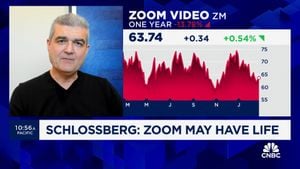Earth is set to welcome a temporary celestial neighbor! Starting September 29, 2024, the small asteroid known as 2024 PT5 will be pulled by our planet’s gravity, entering its orbit as what astronomers call a "mini-moon." This cosmic phenomenon is expected to last until November 25, offering scientists a unique chance to study this head-turning space rock.
Discovered by the Asteroid Terrestrial-Impact Last Alert System (ATLAS), this tiny asteroid measures about 33 feet long, roughly equivalent to the length of a city bus. Its discovery was detailed by researchers from the Universidad Complutense de Madrid, who recorded their findings in the journal Research Notes of the American Astronomical Society. They anticipate 2024 PT5 will engage Earth’s gravitational pull before speeding off again to continue its orbit around the Sun.
Unlike natural moons which stay with their planets, 2024 PT5 is only set to spend about 56 days with Earth. Carlos de la Fuente Marcos, co-author of the study, described the event as more like "a brief gravitational dance" rather than full ownership. Due to its small size and dim visibility, it may be challenging for the average observer to spot 2024 PT5 with the naked eye or regular telescopes.
This isn’t the first time Earth has been graced with mini-moons. Previous instances included the asteroid 2020 CD3 and RH120 back between 2006 and 2007. Each of these celestial visitors offered valuable insights for astronomers studying near-Earth objects, and now, 2024 PT5 offers another opportunity to glean information about the origins and behavior of asteroids as they flirt with our gravitational grasp.
Now, let’s take a step back and reflect on how such mini-moons are identified. The ATLAS program, funded by NASA, is renowned for its surveillance, enabling it to detect asteroids on paths coming close to our planet. After spotting 2024 PT5, the program reassured the public: there’s no danger of this mini-moon crashing onto Earth. Rather, it’s simply entering and exiting our cosmic neighborhood without causing trouble.
The origin of this asteroid is thought to lie within the Arjuna asteroid belt, where it loosely shares its path around the Sun with Earth. It’s fascinating to realize this belt consists of space rocks moving at slower speeds, making them more susceptible to Earth’s gravitational pull. During its approach, 2024 PT5 will pass Earth at about 2.8 million miles away—plenty of distance to keep our planet safe!
Despite the excitement about this upcoming mini-moon, it’s worth noting the challenges of witnessing its fleeting visit. While professional astronomers can observe it with adequate equipment, amateur astronomers might find themselves at a disadvantage. 2024 PT5 requires telescopes with diameters of at least 30 inches to see clearly. Marcos articulated, "A telescope with sufficient equipment will be necessary to observe this object — your average eyeball will just not cut it this time!"
Once it wraps up its brief sojourn around our planet, 2024 PT5 is expected to trek back to its previous path, possibly rejoining the Arjuna belt until its next anticipated visit to Earth, projected around 2055. The life of asteroids like 2024 PT5 often includes such opportunities for temporary orbits, reminding us of our planet’s dynamic relationship with its surroundings.
This isn’t just astronomy for astronomy's sake, either. Each mini-moon appearance helps scientists develop models explaining near-Earth object behavior, deepening our comprehension of potential hazards or resources they might provide should we venture out to them someday. Almost like getting to peek under the hood of these traveling space rocks, this mini-moon study could unearth more about our own solar system and the cosmic history it shelters.
For many, the fascination with mini-moons and asteroids might evoke thoughts of spectacular impacts or imaginings of their origins right adjacent to Earth. Rest easy, though! 2024 PT5 is set to be nothing more than a passing guest; its brief stay will allow scientists to observe and learn but poses no threat whatsoever to our little blue planet.



